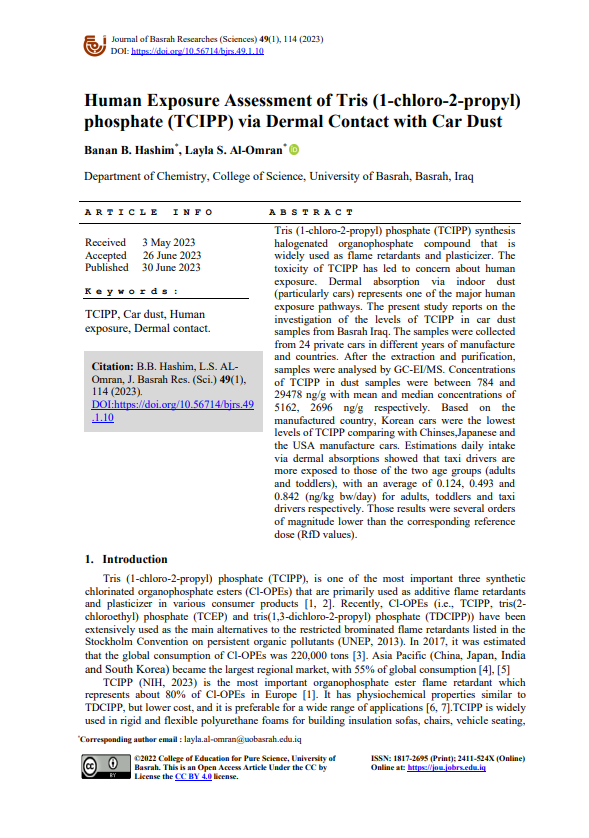Human Exposure Assessment of Tris (1-chloro-2-propyl) phosphate (TCIPP) via Dermal Contact with Car Dust
DOI:
https://doi.org/10.56714/bjrs.49.1.10Keywords:
TCIPP, Car dust, Human exposure, Dermal contactAbstract
Tris (1-chloro-2-propyl) phosphate (TCIPP) synthesis halogenated organophosphate compound that is widely used as flame retardants and plasticizer. The toxicity of TCIPP has led to concern about human exposure. Dermal absorption via indoor dust (particularly cars) represents one of the major human exposure pathways. The present study reports on the investigation of the levels of TCIPP in car dust samples from Basrah Iraq. The samples were collected from 24 private cars in different years of manufacture and countries. After the extraction and purification, samples were analysed by GC-EI/MS. Concentrations of TCIPP in dust samples were between 784 and 29478 ng/g with mean and median concentrations of 5162, 2696 ng/g respectively. Based on the manufactured country, Korean cars were the lowest levels of TCIPP comparing with Chinses,Japanese and the USA manufacture cars. Estimations daily intake via dermal absorptions showed that taxi drivers are more exposed to those of the two age groups (adults and toddlers), with an average of 0.124, 0.493 and 0.842 (ng/kg bw/day) for adults, toddlers and taxi drivers respectively. Those results were several orders of magnitude lower than the corresponding reference dose (RfD values).
Downloads
References
Van der Veen, J. de Boer, Chemosphere 88(10), 1119 (2012).
G.L. Wei et al., Environmental Pollution 196, 29 (2015).
M. Alghamdi, M.A.E. Abdallah, S. Harrad, Emerging contaminants 8, 9 (2022).
J. Yang et al., International journal of molecular sciences 20(12), 2874 (2015).
Q.O. Lu et al., Environmental Pollution 318, 120893 (2023).
S.H. Brandsma et al., Chemosphere 116, 3 (2014).
C. Christia et al., Chemosphere 196, 231(2018).
S. Harrad et al., Science of the Total Environment 859 160250 (2023).
M. Antonopoulou et al., Toxic,(12)10 736 (2022).
D. Cao et al., Ecotoxicology and environmental safety 169, 383(2019).
X. Wang et al., Science of the Total Environment 731, 139071 (2020).
C. Bergh et al., Journal of Environmental Monitoring 13(7), 2001 (2011).
D. Cao et al., Environmental science & technology 51(3), 1441 (2017).
W. Li et al., Environment international 133, 105178 (2019).
Y. Ma et al., Environmental toxicology and chemistry 36(2), 414 (2017).
M.H. Chen, W.L. Ma, Science of the Total Environment 783, 147064 (2021).
M. Frederiksen et al., Chemosphere 197, 185 (2018).
M.A..E. Abdallah, G. Pawar, S. Harrad, Environmental science & technology 49(18), 10976 (2015).
S. Brommer et al., Journal of Environmental Monitoring 14(9), 2482 (2012).
N. Ali, N et al., Environment international 55: p. 62-70 (2013).
N. Ali et al., Science of the Total Environment 569, 269 (2016).
M.A.E. Abdallah, A. Covaci, Environmental science & technology 48(9), 4782 (2014).
S. Harrad, S. Brommer, J.F. Mueller, Emerging Contaminants 2(2), 66 (2016).
S. Brommer, S. Harrad, Environment international 83, 202 (2015).
J. Cristale et al., Environmental Pollution 237, 695 (2018).
H. Stuart et al., Environment international 34(8), 1170 (2008).
L.S. Al-Omran et al., Emerging Contaminants 7, 204 (2021).
S.H. Brandsma et al., TrAC Trends in Analytical Chemistry 43, 217 (2013).
C. He et al., Talanta 164, 503 (2017).
A. de la Torre et al., Journal of Hazardous Materials 382, 121009(2020).
G. Pawar et al., Journal of exposure science & environmental epidemiology 27(1), 100 (2017).
M.A.E. Abdallah, S. Harrad, Environmental Research 209, 112847(2022).
O.A. Abafe, B.S. Martincigh, Chemosphere 230, 239 (2019)
R. Olivero-Verbel, B. Johnson-Restrepo, E. Eljarrat, Journal of Environmental Exposure Assessment 1(2), 8 (2022).
L. Zhou et al., Environmental Science and Pollution Research 24(12), 10992 (2017).
M. Tokumura et al., Environmental monitoring and assessment 189, 1 (2017).
N. Ali et al., International journal of environmental research and public health 18(9), 4803 (2021).
UNEP, Listing of POPs in the Stockholm convention (2023). Available online: http://chm.pops.int/TheConvention/ThePOPs/ListingofPOPs/tabid/2509/Default.aspx
European Commission. Commission directive 2014/79/EU of 20 June 2014 amending Appendix C of Annex II to Directive 2009/48/EC of the European Parliament and of the Council on the Safety of Toys, as Regards TCEP, TCPP and TDCP. Off. J. E. U. 2014, 182, 49–51. Available online: http://data.europa.eu/eli/dir/2014/79/oj
NIH, National Library of Medicine (2023). Available online: https://pubchem.ncbi.nlm.nih.gov/compound/Tris_1-chloro-2-propyl_-phosphate
U.S. EPA. US Environmental Protection Agency. (2011). "Exposure Factors Handbook; Chapter 5—Soil and Dust Ingestion" Available online: https://www.epa.gov/sites/default/files/2015-09/documents/efh-chapter05.pdf
U.S. EPA. US Environmental Protection Agency. (2017) “Update for Chapter 5 of the Exposure Factors Handbook - Soil and Dust Ingestion” Available online: https://cfpub.epa.gov/ncea/risk/recordisplay.cfm?deid=337521

Downloads
Published
Issue
Section
License
Copyright (c) 2023 Banan B. Hashim, Layla S. Al-Omran

This work is licensed under a Creative Commons Attribution 4.0 International License.







